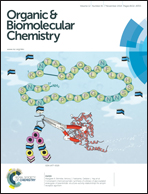Regiodivergent and short total synthesis of calothrixins†
Abstract
The anionic annulation of MOM-protected furoindolone with 4-bromoquinoline followed by deprotection of the N-MOM group provides calothrixin B, whereas that with 3-bromoquinoline yields isocalothrixin B. The outcomes are explained by the divergence of the reaction mechanism from commonly perceived quinolyne intermediate. A sequence of addition–cyclization–elimination is proposed to account for the formation of calothrixin from 4-bromoquinoline.


 Please wait while we load your content...
Please wait while we load your content...